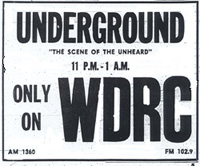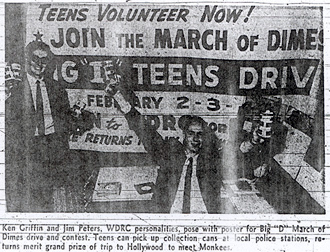
©
1999-2025
Man From Mars Productions
|
Programming
|
 |
|
|
|
|
Because of the hours he worked (8PM-1AM), Ken Griffin's audience was primarily teenagers. He spent hours each night on the phone taking requests (Instant Replays) and playing dedications. He seamlessly transitioned between his own voice and those of his characters, Phats Phontoon and her boyfriend, Rocky Hill. All of it was done live. |
 |
 |
In August of 1968, Ken began a regular two-hour late-night program of underground music. A newspaper article of the era described it as "any recorded sound not available in a general program format." Dropping the jingles and usual high-energy formatics (as well as his first name), Griffin played heavy doses of new music by artists like Cream, Donavon, Judy Collins, Jimi Hendrix and Bob Dylan. Later, the show was hosted by Dick Sandhaus. |
|
Jim Nettleton's departure for Philadelphia in August, 1966 proved to be the opening of a floodgate of midday hosts. He was replaced by Joel Cash, who had been one of The Friendly Five four years earlier. But he stayed only till late December when Lee Vogel arrived from Buffalo; his stay was just eight months. Jim Peters arrived in August, 1967. After cutting his teeth on FM, he took over the mid-morning slot on Big D 1360. Charlie Parker and music director Bertha Porter worked out the logistics of an all-request show from 9AM-noon. In December, Peters moved back to FM until his departure for Hawaii a few months later. Middays got a new host in John Rode - the fifth voice to occupy the time slot in a year and a half. |
 |
 |
It's hard to imagine now, but FM stations in the mid 1960s were pretty much non-entities. No one knew what to do with them. In WDRC's case, virtually everything aired on AM 1360 was simulcast on FM 102.9. Then, the FCC decided that stations with AM/FM combinations must provide some separate programming. A formula based on market size was developed and it meant Big D FM had to originate different programming at least 50% of its 20-hour broadcast day starting in mid 1967. Coincidentally, the station was in the midst of building new studios at 750 Main Street in Hartford so an extra FM studio would be required. At the time, WDRC was fully unionized with each DJ having a control room engineer. The jocks controlled their microphone and turntables, but the engineer played commercials, jingles, and controlled any reel-to-reel tape playback for contests. The new physical setup at WDRC FM required personalities to run the entire show on their own, without a combo operator, which was a major adjustment for some air talent who had never done so. As Charlie Parker hired additional announcers to staff FM, he looked for people experienced at running their own console. From that point on, most announcers started on FM to get a feel for the format before moving over to the more-important AM, including Kent Clark, Bradley Field, Jim Peters, Jim Jeffrey, John Scott, Stephen Kane, Dick McDonough and Larry Justice. |
|
Charlie had a knack for inventing promotions which pitted the deejays against each other in friendly competitions. They provided entertainment value for listeners, drew crowds for sponsors, and gave the personalities something to talk about on the air.
Click for Scotty Morgan's photo page from January, 1970. |
